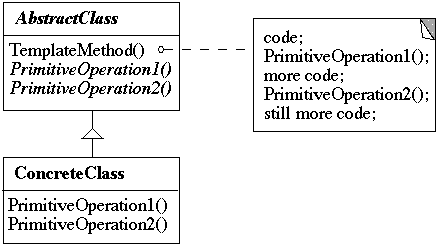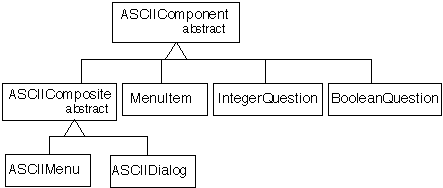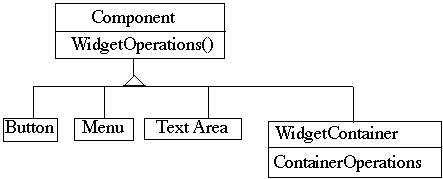
Spring Semester, 1999
Assignment 2 Comments
© 1999, All Rights Reserved, SDSU & Roger Whitney
San Diego State University -- This page last updated 21-Mar-99

|
CS 535 Object-Oriented Programming & Design Spring Semester, 1999 Assignment 2 Comments |
|
|---|---|---|
|
© 1999, All Rights Reserved, SDSU & Roger Whitney San Diego State University -- This page last updated 21-Mar-99 |
public BooleanQuestion(String message, String methodName1, String methodName2, Object objectName1, Object objectName2 ) public BooleanQuestion(String message, String trueCallbackMethod, Object trueReceiver, String falseCallbackMethod, Object falseReceiver)
public class ConsoleQuestionThing public class MenuManager public class Menu
pubic void addOption( Option option, Object exetutee, String methodName)
String szHeader; Vector vAvailableOptions; int iSize;Hungarian naming style is common in the Window environment. While I personally do not use the style, it is acceptable as long as one is consistent in its usage. See http://ivory.lm.com/~gregleg/hungarian.html or http://www.strangecreations.com//library/c/naming.txt, or http://www.stanford.edu/~croyer/hungarian.html for more information.
public class StringQuestion
{
public void displayQuestion()
{
try
{
Console.println( theQuestion );
String response =
Console.readln( "Your answer: ");
method.invoke( executee, new String[] {response});
}
catch (IllegalAccessException willNotOccur )
{
Console.println("Illegal Access of Method");
Runtime.getRuntime().exit( 1 );
}
catch (IllegalArgumentException wrongType)
{
Console.println("Illegal Access of Method");
}
catch (InvocationTargetException methodLost)
{
Console.println("Could not find method");
}
}
}
Printing
error messages to the screen in this class reduces it reusability. The
application may not want that to happen, or happen in this way. The exit() is a
bigger problem. The application may wish to attempt to recover, it may need to
save files before exiting.
pubic class Question {
public String stringQuestion( String message ) {
System.out.println( "message" );
System.out.println( "Your answer: " );
String response = Console.readLine().trim();
return response;
}
public boolean booleanQuestion( String message ) {
try {
System.out.println( "message" );
System.out.println( "Your answer: " );
booelan response = Console.readBoolean();
Console.flushLine();
return response;
} catch (NumberFormatError badInput ) { //blah}
}
public int intQuestion( String message ) {
try { //blah
} catch (NumberFormatError badInput ) {//more blah }
}
}
What
is the abstraction? Where is the data?
public void method1() {
int foo = 12;
//blah
statement1;
statement2;
statement3;
// more blah
}
public void method2() {
int bar = 42;
//stuff
statement1;
statement2;
statement3;
// more stuff
}
public void method1() {
int foo = 12;
//blah
foo = repeated( whatGoesHere );
// more blah
}
public void method2() {
int bar = 42;
//stuff
bar = repeated( something );
// more stuff
}
public int repeated(Object agrument) {
statement1;
statement2;
statement3;
return result;
}
public void run() {
while (true) {
try {
System.out.print( message );
int selection = Integer.parseInt( keyboard.readLine() );
System.out.println();
execute( selection);
} catch (InvalidSelectionException ise) {
//handle invalid selection
} catch (OptionDisabledException ode ) {
// handle disabled option
}
}
}
private void execute( int selection ) throws IOException {
if ( !isValid( selection ) )
throw new InvalidSelectionException("Invalid Selection");
Option selectedOption = menuOption.at( selection );
if ( !option.isEnabled() )
throw new OptionDisabledException("Option is disabled");
//now execute the method
}
Before
going on, you should be able to suggest a number of improvements to this code
public void run() {
while (true) {
try {
int selection = getUsersSelection( );
if ( !isValid( selection ) )
//handle invalid selection;
Option selectedOption = menuOption.at( selection );
if ( !option.isEnabled() )
// handle disabled option;
execute( selection);
} catch (//YouCanFillInTheRest );
}
}
private int getUsersSelection() {
System.out.print( message );
int selection = Integer.parseInt( keyboard.readLine() );
System.out.println();
return selection;
}
public void execute( int selection ) throws IOException {
//now execute the method
}
/**
* Requires selection is valid selection and
* the selection is not disabled
*/
public void execute( int selection ) throws IOException {
//now execute the method
}
/**
* Requires selection is valid selection and
* the selection is not disabled
*/
public void execute( int selection ) throws IOException {
Assert.condition( isValid( selection ));
Assert.condition( menuOption.at( selection ).isEnabled() );
//now execute the method
}
import java.io.BufferedReader;
import java.io.InputStreamReader;
import java.io.IOException;
public class IntegerQuestion {
private static BufferedReader keyboard =
new BufferedReader( new InputStreamReader(System.in));
private String questionText;
private int answer;
public IntegerQuestion( String question) {questionText = question; }
public int answer() { return answer; }
public void askQuestion() throws IOException {
boolean haveValidAnswer = false;
while (!haveValidAnswer) {
String rawResponse = null;
try {
System.out.println( questionText );
System.out.print( "Your answer: " );
rawResponse = keyboard.readLine();
answer = Integer.parseInt( rawResponse.trim() );
haveValidAnswer = true;
} catch (NumberFormatException badInput ) {
System.out.println();
System.out.println( rawResponse +
"is not a valid integer. Please try again. " );
System.out.println();
}
}
}
}
import java.io.BufferedReader;
import java.io.InputStreamReader;
import java.io.IOException;
public class StringQuestion {
private static BufferedReader keyboard =
new BufferedReader( new InputStreamReader(System.in));
private String questionText;
private String answer;
public StringQuestion( String question) {questionText = question; }
public String answer() { return answer; }
public void askQuestion() throws IOException {
boolean haveValidAnswer = false;
while (!haveValidAnswer) {
String rawResponse = null;
System.out.println( questionText );
System.out.print( "Your answer: " );
answer = keyboard.readLine().trim();
if (answer.length() > 0 )
haveValidAnswer = true;
else {
System.out.println();
System.out.println( rawResponse +
"is not a valid integer. Please try again. " );
System.out.println();
}
}
}
}

public ASCIIComponent( String text ) public void enable() public void disable() public boolean isEnabled() public void display() public String toString() public Object response() public void run() throws IOExceptionSubclass override the following to provide special behavior
protected void respondToUserInput() throws IOException protected String badInputMessage( String badInput ) protected String getUserResponse() throws IOException protected boolean validateAndStore( String userText)
package sdsu.awt;
import java.io.BufferedReader;
import java.io.InputStreamReader;
import java.io.IOException;
import java.io.PrintWriter;
public abstract class ASCIIComponent {
protected static final String NEW_LINE =
System.getProperty( "line.separator" );
protected static BufferedReader in =
new BufferedReader( new InputStreamReader(System.in));
protected static PrintWriter out = new PrintWriter( System.out, true );
protected String displayText;
protected Object userResponse;
protected boolean isEnabled = true;
public ASCIIComponent( String text ) { displayText = text; }
public void enable() { isEnabled = true; }
public void disable() { isEnabled = false; }
public boolean isEnabled() { return isEnabled; }
public void display() { out.println( toString() ); }
public String toString() {
if (!isEnabled)
return "Disabled" ;
else
return displayText;
}
public Object response() { return userResponse; }
public void run() throws IOException {
if (!isEnabled)
return;
boolean haveValidAnswer = false;
while (!haveValidAnswer) {
display();
String rawResponse = getUserResponse();
haveValidAnswer = validateAndStore( rawResponse );
if (!haveValidAnswer)
displayBadInputMessage( rawResponse );
}
respondToUserInput();
}
/** Sublcass to override to provide specialized action is
* response to user inputing valid data.
* @exception IOException on IO problems reading users
* response
*/
protected void respondToUserInput() throws IOException { }
protected void displayBadInputMessage( String badInput ) {
out.println();
out.println( badInputMessage ( badInput ) );
out.println();
}
/** Sublcass to override to provide specialized message
* when user input invalid data.
* @param badInput text entered by user
*/
protected String badInputMessage( String badInput ) {
return badInput + " is not valid input. Please try again.";
}
/** Sublcass to override to provide specialized prompting
* of user and reading of users response.
* @exception IOException on IO problems reading users
* response
*/
protected String getUserResponse() throws IOException {
out.print( "Your answer: " );
out.flush();
return in.readLine();
}
/** Sublcass to override to provide validation of user input
* Store validated user input in userResponse
* Return true if input is valid
*/
protected boolean validateAndStore( String userText) {
this.userResponse = userText;
return true;
}
}
package sdsu.awt;
public class IntegerQuestion extends ASCIIComponent {
public IntegerQuestion( String text ) {
super( text);
}
protected String badInputMessage( String badInput ) {
return badInput + " is not a valid integer. Please try again.";
}
protected boolean validateAndStore( String userText) {
try {
userResponse = new Integer( userText.trim() );
return true;
}
catch (NumberFormatException badInput ) {
return false;
}
}
}
package sdsu.awt;
import java.util.List;
import java.util.Arrays;
public class BooleanQuestion extends ASCIIComponent {
private List trueAnswers =Arrays.asList( new String[] { "true", "t", "yes", "y" });
private List falseAnswers =Arrays.asList( new String[] { "false", "f", "no", "n" });
public BooleanQuestion( String text ) { super( text); }
protected String badInputMessage( String badInput ) {
return badInput + " is not a valid true/false response. " +
NEW_LINE + "Use true, t, yes, or y for positive response" +
NEW_LINE + "Use false, f, no, or n for negative response" +
NEW_LINE + "Please try again";
}
protected boolean validateAndStore( String userText) {
userText = userText.trim().toLowerCase();
if (trueAnswers.contains( userText ) ) {
userResponse = new Boolean( true );
return true;
}
if (falseAnswers.contains( userText ) ) {
userResponse = new Boolean( false );
return true;
}
return false;
}
}

Template methods tend to call:

public ASCIIComposite( String title ) public void add( ASCIIComponent aComponent ) public void remove( ASCIIComponent aComponent ) public void insert( ASCIIComponent aComponent, int index ) public ASCIIComponent get( int index) public int getItemCount() public void enableComponent( int index ) public void disableComponent( int index ) public void display()
package sdsu.awt;
import java.util.ArrayList;
public abstract class ASCIIComposite extends ASCIIComponent {
ArrayList components = new ArrayList();
public ASCIIComposite( String title ) { super( title ); }
public void add( ASCIIComponent aComponent ) {
components.add( aComponent );
}
public void remove( ASCIIComponent aComponent ) {
components.remove( aComponent );
}
public void insert( ASCIIComponent aComponent, int index ) {
components.add(index, aComponent );
}
public void enableComponent( int index ) {
ASCIIComponent toEnable = get( index);
toEnable.enable();
}
public void disableComponent( int index ) {
ASCIIComponent toDisable = get( index);
toDisable.disable();
}
public void display() {
out.println();
if (!isEnabled)
out.println("Disabled");
out.println( "*** " + toString() + " ***" );
for (int k = 0; k < components.size(); k++ )
out.println( "" + (k) + ") " + get(k) );
out.println();
}
public ASCIIComponent get( int index ) {
return (ASCIIComponent) components.get( index);
}
public int getItemCount() { return components.size(); }
}
package sdsu.awt;
import java.io.IOException;
public class ASCIIMenuItem extends ASCIIComponent {
public ASCIIMenuItem( String text) { super(text); }
public void run() throws IOException { respondToUserInput(); }
}
package sdsu.awt;
import java.util.ArrayList;
import java.io.IOException;
public class ASCIIMenu extends ASCIIComposite {
public ASCIIMenu(String title ) { super(title ); }
public void add( String menuItemText ) {
add( new ASCIIMenuItem( menuItemText ));
}
protected String badInputMessage( String badInput ) {
return badInput + " is not a valid integer between 0 and " +
(getItemCount() - 1) + "." + NEW_LINE + "Please try again.";
}
protected boolean validateAndStore( String userText) {
try {
int selection = Integer.parseInt( userText.trim() );
if (( selection < 0 ) || ( selection >= getItemCount() ) )
return false;
userResponse = new Integer( selection );
return true;
} catch (NumberFormatException badInput ) {
return false;
}
}
protected void respondToUserInput() throws IOException {
int selection = ((Integer) userResponse).intValue();
ASCIIComponent selectedItem = get( selection );
selectedItem.run();
}
}
package sdsu.awt;
import java.util.ArrayList;
import java.io.IOException;
public class ASCIIDialog extends ASCIIComposite {
public ASCIIDialog(String title ) { super(title ); }
public void run() throws IOException {
if (!isEnabled)
return;
display();
ArrayList responses = new ArrayList();
for (int k = 0; k < getItemCount(); k++ ) {
ASCIIComponent item = get( k );
item.run();
out.println();
responses.add( item.response() );
}
userResponse = responses;
}
}

class WidgetContainer {
Component[] myComponents;
public void update() {
if ( myComponents != null )
for ( int k = 0; k < myComponents.length(); k++ )
myComponents[k].update();
}
}